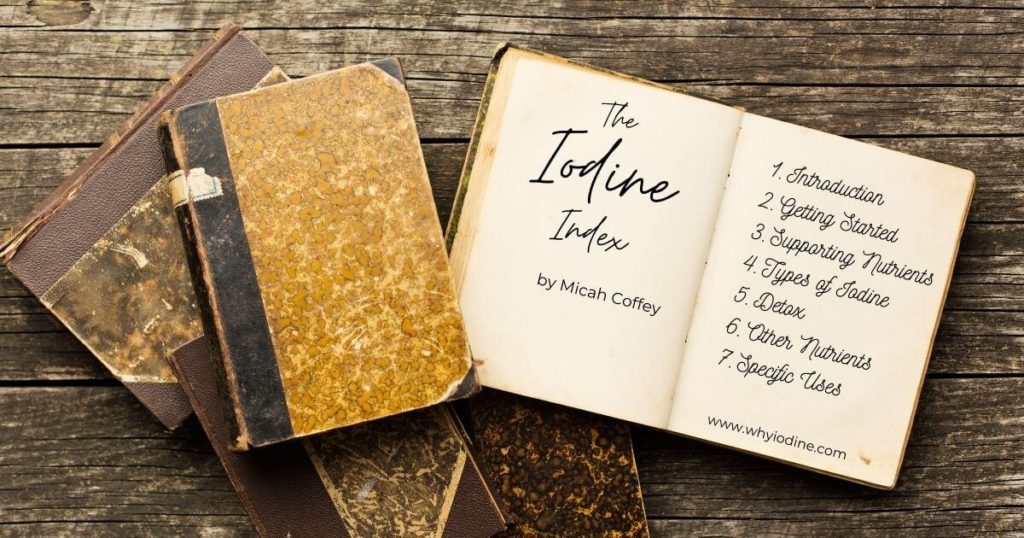
Many women report changes in their menstrual cycle when starting iodine. Although there is not any direct science between iodine and menstrual cycles, cycles themselves are not really an exact science or completely understood. Their activity is heavily influenced by diet, gene status, stress and many other factors.
Common changes include:
- Cycles starting days or weeks before their normal schedule
- Cycles lasting longer or shorter than usual 1
- Cycles returning, even close to menopause
- Increased or decreased flow 2 3
- Increased or decreased pain
- Increased appetite during cycle
- Energy levels and mood
Most of these changes are most likely due to changes in hormone levels. Iodine is required to create thyroid hormones, and these hormones are a big part of our metabolism. As long as we have the other nutrients required for metabolism, increasing these thyroid hormones can drastically increase our metabolism, which has a large influence on a lot, if not all of our other hormones.
Iodine levels and resulting thyroid function have links to issues in breast health 4, ovarian dysfunction 5 and PCOS 6. These aspects are an integral part of overall health.
Since 1928, the iodine concentration in the ovary has been known to be higher than in every other organ except the thyroid(which tends to have a 100:1 ratio of iodine). The ovarian iodide uptake varies with sexual activities, is enhanced by estrogens and a hypothyroid state, and blocked by goitrogens. The recent discovery of a sodium iodide symporter (NIS) in ovaries has offered a possible mechanism for ovarian iodide uptake and other functional similarities to its thyroid counterpart. Ovary-born T3(T3 requires iodine) has been witnessed in rabbits, pigs, horses. 7
Hypothyroidism can result in a marked delay in sexual development in males and, conversely, in precocious puberty, the anticipation of pubertal development set point, menstrual disturbances and reduced fertility in females. 8
Related content
There is a good bit of info and discussion about hormone imbalances increasing the risk of several cancers. Some people refer to them as “hormone driven cancer”. I will eventually pull together some more information about this to help explain how and why hormones are involved in this, but it can essentially be looked at the same way as any other toxins that are causing us issues. Our environment is loaded with hormone-mimicking substances. Plastics, non-stick cookware, and other common things including odd stuff like hand sanitizer and receipt paper can dose us with various amounts of these “xenohormones” which are just hormones not produced by our body and not found in nature.
Hyperoestrogenic state characterized by relatively high production of oestrone and oestradiol and a relatively low oestriol to oestrone plus oestradiol ratio may increase the risk of breast, endometrial, and ovarian cancer. Increasing dietary iodine intake may reduce the risk of these cancers. 9
But keep in mind that iodine is just one piece of this puzzle. Once we become far enough behind on these important nutrients, imbalances can build up that require diligence in order to resolve. I focus on nutrition first with small amounts of iodine, and as I have time and energy while my detox is going well, I slowly increase my iodine without pushing myself too far. Read more about how I handle this at my other site sickoftired.com.
I will eventually pull more info together about these two supplements, but for now, you may want to do your own research into DIM and CDG in relation to hormone balancing. Iodine can help balance hormones, but it can not do so very quickly. CDG helps support a channel in our liver that breaks down and recycles hormones, which can drastically help reduce the burden on our liver for some people. DIM works a little differently by sort of knocking hormones loose. More research should be done before using DIM or broccoli sprouts and cruciferous vegetables can be used to. CDG is a bit more commonly used. Seeking Health carries CDG. Read more about CDG + DIM at sickoftired.com/cdg and check out the video where my wife stops in to share how much she likes these nutrients.
- https://pubmed.ncbi.nlm.nih.gov/8051643/
- https://www.ncbi.nlm.nih.gov/pmc/articles/PMC1117669/
- https://pubmed.ncbi.nlm.nih.gov/9238278/
- https://journals.lww.com/oncology-times/fulltext/2016/12250/how_molecular_iodine_attacks_breast_cancer.13.aspx
- https://pubmed.ncbi.nlm.nih.gov/2499590/
- https://www.ncbi.nlm.nih.gov/pmc/articles/PMC3832324/
- https://pubmed.ncbi.nlm.nih.gov/15927769/
- Handbook of diet and nutrition in the menstrual cycle, periconception and fertility – https://www.wageningenacademic.com/doi/abs/10.3920/978-90-8686-767-7_14
- https://pubmed.ncbi.nlm.nih.gov/58152/
